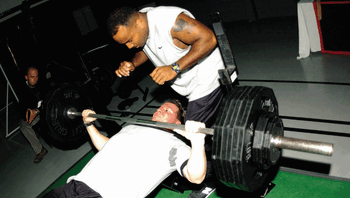
A soldier (lying down) performs a bench press with a spotter
Spotting, in weight or resistance training, is the act of supporting another person during a particular exercise, with an emphasis on allowing the participant to lift or push more than he or she could normally do safely.
Correct spotting involves knowing when to intervene and assist with a lift, and encouraging a training partner to push beyond the point in which they would normally 'rack' the weight (return it to its stationary position).
Spotting relies partially on the placebo effect, whereby simply touching underneath a bar is enough to trick a person into believing that they are lifting a weight supported by their training partner which in turn may allow them to push one or two more repetitions beyond which they were normally capable and lower their hesitance to continue lifting, feeling safer with a spotter.
Spotting is particularly prevalent, and recommended when performing the bench press. Because of the risks of lifting a heavy weight in the supine position, a lifter will often ask for a spot unless he or she is completely confident that the lift will not be failed. While a spotter may prevent injury, a lifter may become too dependent on the spotter, and not realize the degree that the spotter is assisting them. This is sometimes jocularly referred to as the "two man bench press".
Another exercise in which a spotter is recommended is the Barbell Squat. For this exercise the spotter will be about 2 ft behind their partner. When their partner begins the lift the spotter will stand behind them, with their hand's "ready to catch" their partner. This is crucial especially with heavy weight, where a slight loss of balance could injure the lifter. Unlike other exercises this exercise does not present much of a chance for the spotter to assist the lifter, as the spotter only intercedes in the event of a missed lift.
Another great exercise to utilize a spotter would be the triceps exercise Skull Crushers in which the lifter lowers a E-Z bar towards their head while laying flat on the bench. The spotter will be standing behind the individual and moving their hands approximately 6 inches below the bar so that they can catch it in the event of the lifter running out of energy.
Additionally, some people prefer to have a spotter present during the Barbell Military Press or Barbell Push Press (two very similar exercises). This exercise involves lifting a considerable amount of weight about the head. During this exercise the spotter will assist in “lifting off” the bar from the racked position. Then the spotter will keep his/her hands about 6 inches under the bar. This allows the spotter to assist when the lifter runs out of energy, but most importantly allows the spotter to catch the weight if the lifter cannot lift any more. A spotter may not be preferred, however, because the risk of injury is lower and it is easier to drop the weight on the ground if the lifter loses control of the barbell.
As a general rule to prevent injury and ensure safety spotters should have the strength to "bail out" their training partner by supporting the entirety of the weight if the lifter loses strength.